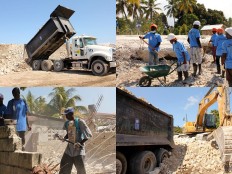Haitian All-Starz
The Best Representation of Haitian Entertainment, Culture, & LifeStyle
Haiti - Reconstruction : In Leogane, 87.000 m3 of rubble removed
 |
This community-based approach allows people living in IDP camps to select specific places as starting points for rubble removal thus working towards cleaning these areas to allow for a safe return to their old neighborhoods.
"It is remarkable to see how, by putting people, communities, local governments and NGOs together, this project has already managed to remove 87,000 cubic metres of rubble from 17 selected neighbourhoods" said Ms Grynspan as she talked to some of the 380 workers from the Mapou Dampus project site.
"This initiative in Leogane is the essence of UNDP's mandate in recovery, putting people and their communities at the centre of the reconstruction efforts. Onse year after the earthquake, we are now in the transition from the humanitarian phase to development, finding ways to rebuild Haiti stronger and better," she added.
Besides contributing to the economic recovery of the community and the strategy of return, the project also aims to reinforce the capacity of the local authorities to supervise the ongoing work so that the municipality of Leogane can take ownership to oversee and coordinate NGO interventions and reconstruction of the region.
According to Alexis Santos, mayor of Leogane, 10 months after the earthquake nothing significant had been done to remove and manage the debris in the town until the launch of UNDP's project. "Only UNDP has offered to support the municipality in strengthening its capacity to become a leader and coordinator", he wrote in a letter sent to UNDP on 31 January. "The progress made in the past two months was very significant and has opened the path for Leogane's reconstruction".
To date, 1,640 workers have been temporarily employed to remove rubble and 240 damaged houses demolished using a combination of heavy machinery and high intensive labour activities. So far, 87,000 cubic metres of debris have been taken to a special site for stockpiling and treatment, where at a later stage, workers will also sort, crush and dispose of debris following technical and environmental specifications. The same site will host a recycling centre that will use some of the debris to produce paving blocks for road repairs, creating longer term and sustainable job opportunities for the local population and contributing to the economic recovery of the region.
Article By HL/ HaitiLibre
Social Network
All-StarZ TV
Events
Birthdays
© 2025 Created by Haitian All-Starz.
Powered by
![]()
 Haitian Gourde Converter
Haitian Gourde Converter



You need to be a member of Haitian All-Starz to add comments!
Join Haitian All-Starz